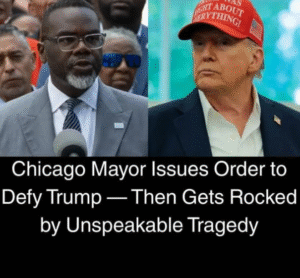Blood and Blame: Chicago’s Violent Weekend and the Clash Over Trump’s Offer of Help
Over Labor Day weekend, Chicago was rocked by a wave of gun violence that left at least 54 people shot and 7 dead. The shootings occurred across 32 separate incidents, including three mass shootings in Bronzeville, Oakland, and Humboldt Park. Victims ranged from teenagers to senior citizens. Families mourned. Communities reeled. And the nation watched.
But what followed was not unity.
It was confrontation.
President Donald Trump seized on the tragedy to renew his long-standing criticism of Chicago’s crime rates and Democratic leadership. “Chicago is the worst and most dangerous city in the world, by far,” he wrote on Truth Social. “Pritzker needs help badly, he just doesn’t know it yet. I will solve the crime problem fast, just like I did in DC. Chicago will be safe again, and soon.”
And then he said the words that turned a crisis into a constitutional debate:
“We’re going in.”
🧠 The Numbers Behind the Nightmare
The violence was staggering. As reported in , the weekend marked one of the bloodiest holidays in recent memory. Among the victims were:
- A 48-year-old man shot multiple times in Little Village.
- An 18-year-old killed during a drive-by.
- A 63-year-old man whose drowning was ruled a homicide.
- A 25-year-old woman fatally shot inside her apartment.
In , community leaders called for increased support, not just from law enforcement, but from mental health services, youth programs, and violence prevention groups.
But Trump’s response was different.
He didn’t call for resources.
He called for troops.
🔥 The Political Flashpoint
In , Trump confirmed plans to deploy the National Guard to Chicago, citing past successes in Washington, D.C. and Los Angeles. “We’re going in,” he told reporters, though he declined to give a timeline.
Illinois Governor JB Pritzker and Chicago Mayor Brandon Johnson immediately rejected the proposal. Pritzker called it “an illegal invasion,” warning that he would challenge any military deployment in court. Johnson signed an executive order barring local police from cooperating with federal agents on joint patrols or arrests.
In , NBC correspondents explored the tension between residents who want federal help and leaders who fear overreach. Many Chicagoans expressed frustration with rising violence—but also concern about militarization and civil liberties.
The divide was clear.
Trump saw chaos.
Chicago saw complexity.
🧵 The History of Federal Intervention
This isn’t the first time Trump has threatened to send troops into Democratic-led cities. During his first term, he repeatedly clashed with mayors in Baltimore, Portland, and New York. In 2025, he used executive authority to federalize police in Washington, D.C.—a move that drew both praise and alarm.
In , Trump compared Chicago’s situation to D.C., saying, “We cleaned it up. We’ll do the same here.”
But critics argue that Chicago is not D.C. It’s a sovereign city within a state, and deploying troops without consent could violate constitutional boundaries.
Governor Pritzker said it plainly: “There is no emergency. We’ve been fighting crime. We’ve been trying to prevent crime—and it’s been working.”
🌿 The Community’s Response
In , local residents expressed exhaustion. “We’re tired of being a headline,” one woman said. “We need help—but not like that.”
In , a mass shooting near a police station underscored the urgency of the crisis. Officers were overwhelmed. Families were terrified. And the question lingered:
What kind of help is appropriate?
🎭 The Optics of Power
Trump’s critics say his response is more about optics than outcomes. In , he framed the issue as a personal mission—casting himself as the lone figure capable of restoring order.
But others see a political calculation. With the 2026 midterms approaching, Trump’s tough-on-crime stance plays well with his base. Chicago, with its Democratic leadership and history of violence, becomes a symbol.
And symbols are powerful.
Even when they’re painful.
💡 What We Learn
From this weekend, we learn that violence is not just a statistic.
It’s a wound.
We learn that help must be thoughtful. That federal intervention, while sometimes necessary, must respect local autonomy. That crime is not solved by force alone—but by trust, investment, and community.
We learn that leadership is tested in moments of crisis.
And that sometimes, the loudest voice isn’t the wisest.
We learn that Chicago is hurting.
But it’s also resisting.
And in that resistance, there is hope.


